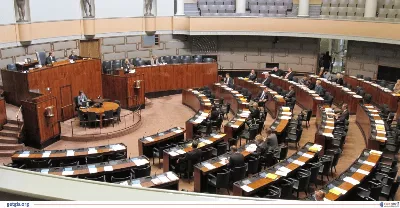“Let Us Handle Immigration”, Canadian Provinces Demand Immigration Autonomy
Updated On
-
Copy link
Canada’s premiers are demanding more say in immigration policy, with Ontario leading the charge by planning 100k provincial work permits to address local workforce needs. This move could redefine how immigration is managed across the country.
At the recent Council of the Federation Summit held in Muskoka, all 13 Canadian provinces voiced a united call for more control over immigration to better meet their provinces' labour and economic needs.
With the growing frustrations over federal delays and rising strain on housing and public services, provincial leaders argue they are better positioned to address their unique workforce gaps.
Ontario Premier Doug Ford Takes Lead
Ontario Premier Doug Ford is spearheading a bold initiative to issue provincial work permits, aiming to sidestep federal red tape. Ford emphasised the urgency of addressing the long wait times for asylum seekers to receive work permits, some stretching even over two years.
“We have healthy, hardworking people sitting in hotels in Etobicoke who want to contribute, but are stuck in limbo.” Mr.Ford also stated that “we are done waiting for the federal government”
His plan relies on Section 95 of the Canadian Constitution, which allows provinces to legislate on immigration matters as long as they don't conflict with federal laws. While the implementation details remain under development, Ford’s team has already begun internal planning, signalling a potential precedent-setting shift in immigration governance
Why Provinces Want More Say in Immigration?
Premiers argue that provinces can more effectively assess and respond to regional labour shortages. Cuts to the Provincial Nominee Program (PNP), which includes a 50% reduction directly have hampered efforts in provinces like Manitoba, Nova Scotia and New Brunswick to attract and retain skilled workers, particularly in rural and underserved areas
Manitoba Premier Wab Kinew warned that reduced immigration capacity could hurt key industries like manufacturing and services. Quebec's Premier, François Legault, also echoed these concerns, highlighting Canada's inefficient asylum system, where decisions can take up to three years, compared to just months in countries like France.
By gaining the ability to issue work permits and manage economic immigration more directly, provinces aim to integrate newcomers faster and reduce the burden on public infrastructure.
Immigration Challenges and Declining Public Support
The support for immigration in Canada has waned recently, with many Canadians pointing to increased pressure on housing and public services. This has led the federal government to introduce policies such as the Strong Borders Bill designed to tighten asylum eligibility and reduce backlogs.
Despite these efforts, Premiers insist that federal measures often ignore regional needs. For instance, Ontario currently houses nearly 100,000 asylum seekers, most of whom cannot work due to permit delays.
Ford argues that empowering these individuals to enter the workforce could reduce their dependence on government aid and boost the local economy through increased tax revenue and consumer spending.
What is Federal Government's Response?
Tensions have escalated between the provinces and Ottawa, especially with the newly appointed Immigration Minister, Lena Diab. Premier Ford criticised Minister Diab for not aligning with what he perceives as Prime Minister Mark Carney's openness to granting provinces more control.
Diab’s spokesperson, Isabelle Buchanan defended the minister’s approach, noting a $3.2 billion investment over 3 years to support 520 settlement organisations outside Quebec. This funding aims to equip newcomers with skills such as language proficiency and professional accreditation.
However, provinces still claim that funding cuts and slow implementation, hinder their ability to support immigrants effectively.
The Economic Case of Regional Control
Supporters of provincial immigration autonomy argue that localizing immigration decisions could better align newcomers with job vacancies in sectors experiencing acute labour shortages like:
- Manitoba needs immigrants for rural manufacturing jobs
- Nova Scotia struggles by delayed work permit approvals
- New Brunswick seeks younger workers to rejuvenate its aging population
By bypassing federal systems, provinces believe that they can integrate newcomers faster with reduced dependency on government programs and respond to local economic pressures more effectively
Read Next: Canada Witnesses Strong Job Growth in June Adds 83,000 New Jobs
Key Challenges Ahead
Despite the enthusiasm, significant legal and logistical barriers still exist. While Section 95 provides a legal basis for provincial immigration powers, any new laws must not conflict with federal services.
Uncertainty remains around how provinces will navigate these complexities without sparking jurisdictional disputes.
Moreover, public scepticism around immigration, especially concerning housing and service access, could also hinder broader support unless carefully managed through transparent communication.
Spotlight on Asylum Seekers
Ford’s plan especially focuses on asylum seekers who are currently unable to work due to federal backlogs. He envisions a system where these individuals can integrate into the workforce quickly, rent homes, and eventually settle down as productive residents.
“They want the same thing every Canadian wants, jobs, housing and stability,” Premier Ford stated.
If successful, this approach will serve as a model for other provinces facing similar challenges.
What Lies Ahead for Canada’s Immigration Policy?
This push for decentralised immigration control marks a pivotal movement in Canada's immigration policy landscape. While the federal government has taken steps like proposing the Strong Borders bill and investing in settlement services, premiers believe that real reform requires shifting more authority to the provincial level.
Ford’s initiative to issue provincial work permits may signal the beginning of a broader transformation. If other provinces follow suit, Canada’s immigration system could evolve into a more regional tailored framework, better aligned with labour market needs and public sentiment.
How GetGIS Assistance Ensure Your Seamless Canada PR Journey?
As the system evolves, staying informed and prepared is crucial for aspirants. For expert guidance on navigating these challenges, consider seeking personalised support from GetGIS
Quick Canada Immigration Updates
- Canada Revises Income Requirements for Sponsoring Parents and Grandparents Under PGP
- Canada’s Average Salaries Jump to $67,466 in 2025, Ontario Outpaces National Average
- Canada Begins Public Consultations for 2026-28 Immigration Strategy
- Ontario Releases 9 In-Demand Jobs for Permanent Residency
- Manitoba Targets Skilled Workers and International Graduates in Latest Draw




